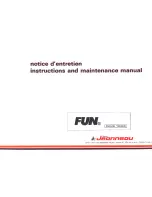
G
E N E R A L
I
N F O R M A T I O N
3–2
F
UEL
S
YSTEM
After fueling, inspect the fuel hoses, connections, and tanks for tightness, signs of leaks. and
deterioration. Annually conduct a more detailed inspection of fuel system components, especially
those hidden from routine inspection. Replace deteriorated hoses, clamps, connections or fittings
immediately.
If you are experiencing fuel flow problems, there is a simple method to determine if the
problem is in your fuel system or your engine. Connect a six-gallon portable tank to your engine.
If the problem persists, the likely cause is with the engine itself. If the problem goes away, the
source must be in the boat’s fuel system. One component that should be inspected if a restriction
occurs is the anti-siphon valve. If fuel does not flow properly through this part it must be cleaned
and/or replaced.
Do not
remove the anti-siphon valve and replace with a regular barb.
F
UEL
S
ELECT
V
ALVE
If your boat is equipped with dual fuel tanks, you will have a manual fuel select valve
installed. This valve allows you to choose from which tank fuel will be consumed. Remember, as
the fuel is consumed and the fuel load redistributes the performance will be influenced. Select the
tank that allows the best performance for your boat.
Aluminum
Angle
To Aux
Tank
Brass Elbow
1/4" Male X 3/8"
Barb
To
Engine
To Main
Tank
3-way Shut
Off Valve
















































